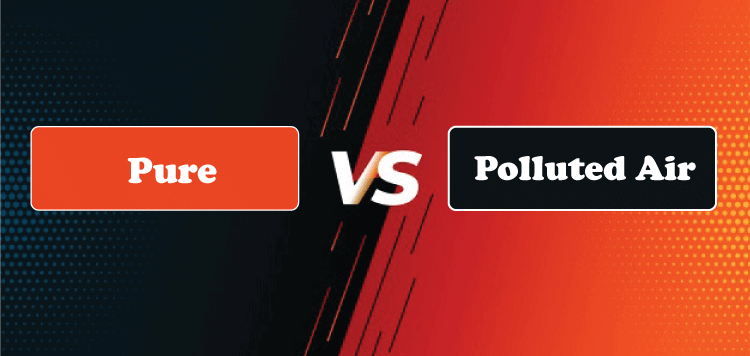Difference between Pure Air and Polluted AirAs we all know, humans need air (usually oxygen) to breathe, but if the air we breathe is not pure, then what will happen to our health as humans is a big question. Well, this can be life-threatening. 
As humans, we all need to breathe clean, fresh air to live a healthy life. This means that the air is free of harmful substances, such as pollutants and toxins, and has a balanced composition of other gases. The air we breathe must contain enough oxygen, which is essential for the body to produce energy and maintain cellular health. In addition to oxygen, the air we breathe should have a balanced composition of other gases, including nitrogen and carbon dioxide. Nitrogen makes up most of Earth's air, while carbon dioxide is present in minimal amounts. These gases regulate the body's pH balance and maintain healthy cellular function. Breathing in polluted air can have negative health effects, including respiratory problems, heart disease, and other health problems. Clean air is essential for good health, and we must ensure our air is free from harmful contaminants. This can include reducing our exposure to pollutants, such as using air filters or avoiding areas with high pollution levels. It is essential to maintain pure air to ensure a healthy and sustainable living environment. This requires collective efforts, including reducing greenhouse gas emissions, promoting green transportation, proper waste management, using clean energy sources, implementing regulations and policies to reduce air pollution, and encouraging public awareness about the importance of clean air. Pure Air: What is it?Pure or clean air refers to air containing a balanced mixture of oxygen, nitrogen, and other natural gases without the presence of toxic gases such as carbon monoxide, sulfur dioxide, nitrogen oxides, or volatile organic compounds (VOCs). Since the pure air is free from harmful contaminants, it is safe to breathe. However, air pollution can contaminate the pure air. Air pollution may come from various sources, such as transportation, industrial activities, agricultural practices, and natural phenomena. Pure air generally benefits human health and has many positive environmental effects. When we breathe pure air, it provides us with a refreshing and invigorating experience. Pure air is also essential for the growth and survival of plants and other organisms. The purest form of air contains no impurities or harmful particles, such as pollutants, allergens, and other toxic gases. The purest form of air is typically found in remote locations, such as high-altitude mountain ranges or pristine forests, with minimal human activity and pollution. Purest air primarily comprises natural gases, including oxygen, nitrogen, and carbon dioxide. However, even the purest form of air can contain small amounts of naturally occurring gases such as methane, water vapor, and helium. Maintaining pure air requires collective efforts, including proper waste management, reducing greenhouse gas emissions, using clean energy sources, promoting green transportation, and planting trees. Regular air quality monitoring, implementing regulations and policies to reduce air pollution, and encouraging public awareness about the importance of clean air are also crucial. In conclusion, pure air is necessary for healthy living, and maintaining it requires a concerted effort from everyone. Polluted Air: What is it?Polluted or dirty air contains high levels of harmful substances, including gases, particles, and chemicals. Breathing in polluted air can cause various health problems, including respiratory diseases, cardiovascular diseases, and cancer. It can also negatively impact the environment, leading to acid rain, global warming, climate change, and other environmental problems like damage to crops, forests, and wildlife. Various sources are responsible for polluted air. These may include vehicle exhaust, industrial emissions, dust and pollen, and natural phenomena such as forest fires and volcanic eruptions. The harmful particles and gases that make up polluted air typically include the following substances:
Reducing air pollution requires collective efforts, including reducing greenhouse gas emissions, promoting green transportation, proper waste management, using clean energy sources, implementing regulations and policies to reduce air pollution, and encouraging public awareness about the importance of clean air. In conclusion, exposure to polluted air can cause various health problems, including respiratory diseases, cardiovascular diseases, and even cancer. It can also have environmental impacts such as acid rain, climate change, and crop, forest, and wildlife damage. Therefore, there is a need for everyone to make concerted efforts to reduce the adverse effects of polluted air. Pure Air vs. Polluted AirPure air refers to an atmosphere that is clean, free of contaminants, and safe to breathe. It contains a balanced composition of gases, including nitrogen, oxygen, and carbon dioxide, and is free from harmful particles, chemicals, or other substances. On the other hand, polluted air contains high levels of harmful substances, such as gases, particles, and chemicals, which can pose health risks to humans and the environment. Various sources, including vehicle exhaust, industrial emissions, dust and pollen, and natural events like wildfires and volcanic eruptions, can cause polluted air. The main differences between pure and polluted air are as follows:
Let us now see the difference between pure and polluted air with the help of the following table:
ConclusionIn summary, pure air is clean and safe to breathe, while polluted air can pose significant health risks and negatively impact the environment. Purified air has a balanced composition and can sometimes contain low levels of harmful substances. In contrast, polluted air contains many harmful substances, which make it contaminated and risky for human beings, other living beings and the environment.
Next Topicdifference-between
|
 For Videos Join Our Youtube Channel: Join Now
For Videos Join Our Youtube Channel: Join Now
Feedback
- Send your Feedback to [email protected]
Help Others, Please Share










